Sustainable Management and Marketing
VerifiedAdded on 2022/12/21
|18
|3026
|79
AI Summary
This document discusses the sustainable management and marketing strategies of H&M group, Nike, Adidas, Primark, ASOS, and Arvind Limited. It explores how these companies manage and use resources effectively to reduce environmental impact. The document also highlights the value dimensions and corresponding questions for each company.
Contribute Materials
Your contribution can guide someone’s learning journey. Share your
documents today.
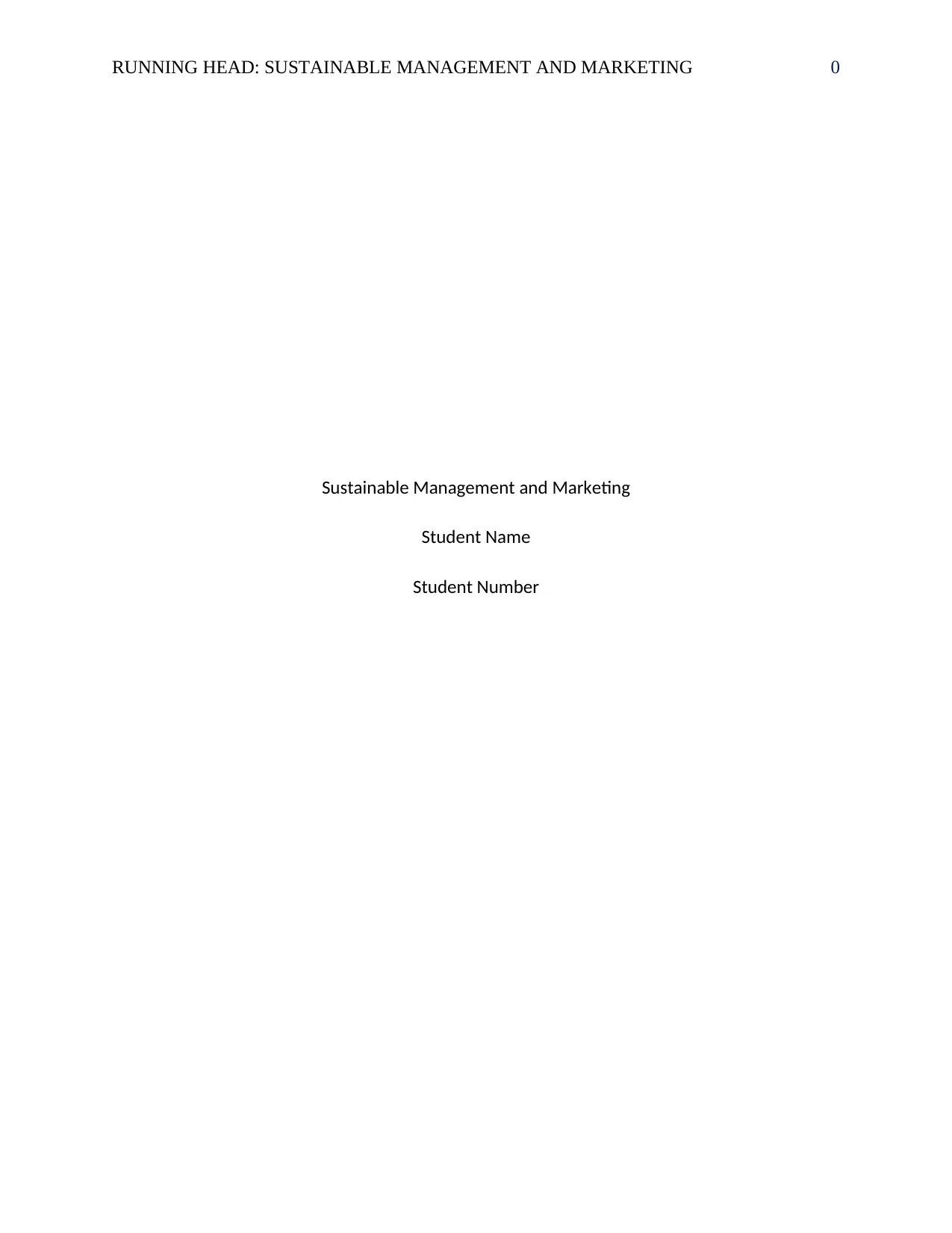
RUNNING HEAD: SUSTAINABLE MANAGEMENT AND MARKETING 0
Sustainable Management and Marketing
Student Name
Student Number
Sustainable Management and Marketing
Student Name
Student Number
Secure Best Marks with AI Grader
Need help grading? Try our AI Grader for instant feedback on your assignments.
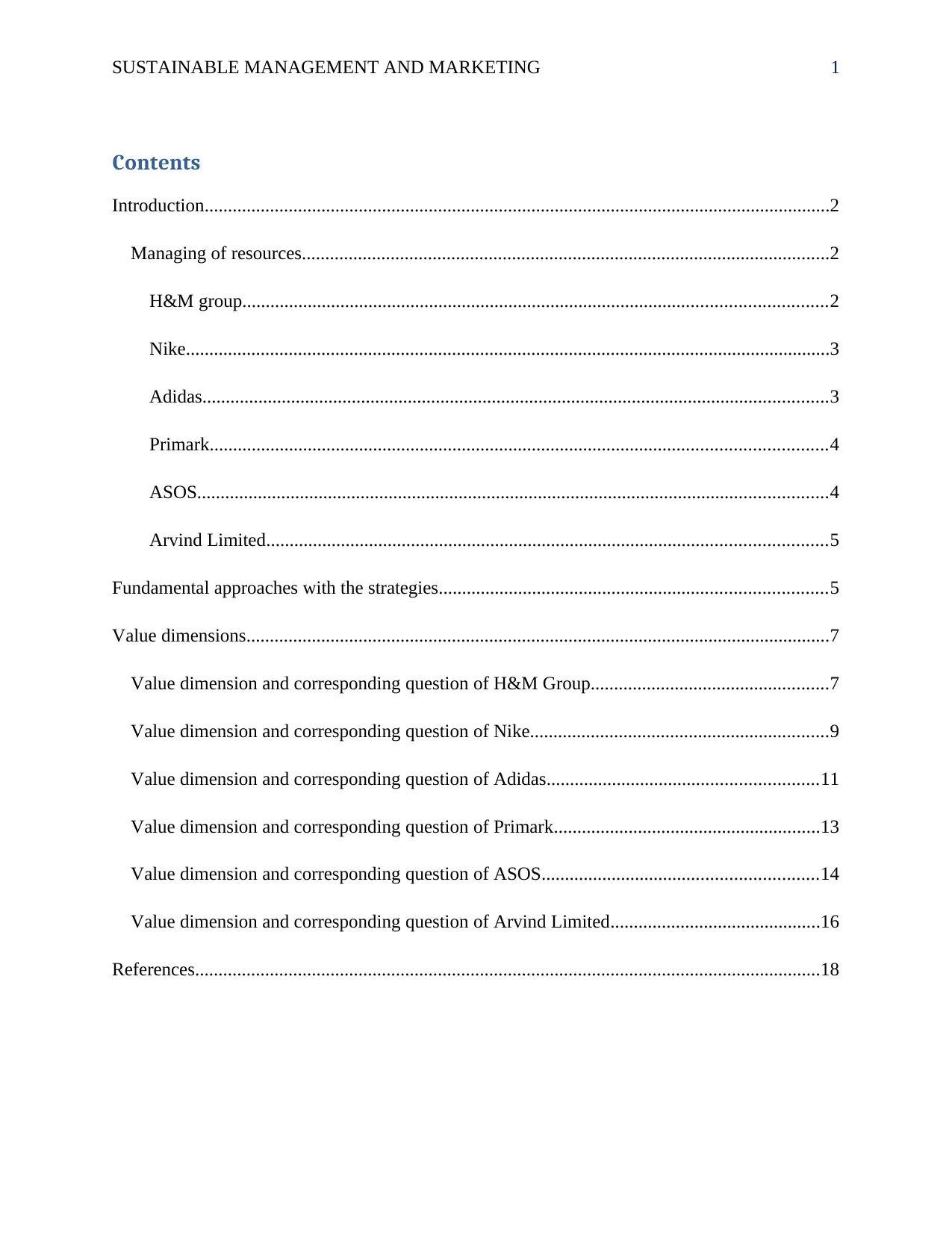
SUSTAINABLE MANAGEMENT AND MARKETING 1
Contents
Introduction......................................................................................................................................2
Managing of resources.................................................................................................................2
H&M group.............................................................................................................................2
Nike..........................................................................................................................................3
Adidas......................................................................................................................................3
Primark....................................................................................................................................4
ASOS.......................................................................................................................................4
Arvind Limited........................................................................................................................5
Fundamental approaches with the strategies...................................................................................5
Value dimensions.............................................................................................................................7
Value dimension and corresponding question of H&M Group...................................................7
Value dimension and corresponding question of Nike................................................................9
Value dimension and corresponding question of Adidas..........................................................11
Value dimension and corresponding question of Primark.........................................................13
Value dimension and corresponding question of ASOS...........................................................14
Value dimension and corresponding question of Arvind Limited.............................................16
References......................................................................................................................................18
Contents
Introduction......................................................................................................................................2
Managing of resources.................................................................................................................2
H&M group.............................................................................................................................2
Nike..........................................................................................................................................3
Adidas......................................................................................................................................3
Primark....................................................................................................................................4
ASOS.......................................................................................................................................4
Arvind Limited........................................................................................................................5
Fundamental approaches with the strategies...................................................................................5
Value dimensions.............................................................................................................................7
Value dimension and corresponding question of H&M Group...................................................7
Value dimension and corresponding question of Nike................................................................9
Value dimension and corresponding question of Adidas..........................................................11
Value dimension and corresponding question of Primark.........................................................13
Value dimension and corresponding question of ASOS...........................................................14
Value dimension and corresponding question of Arvind Limited.............................................16
References......................................................................................................................................18
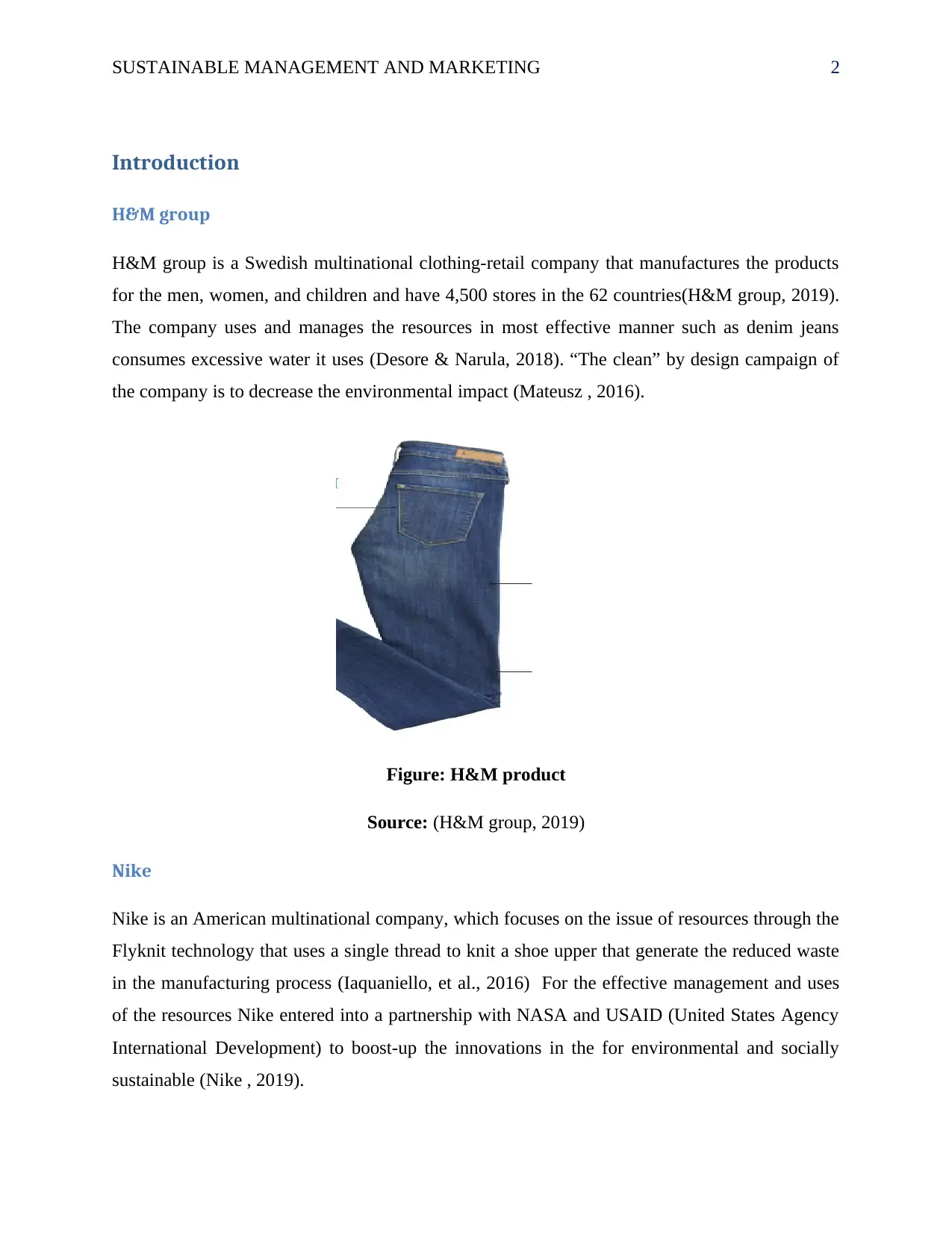
SUSTAINABLE MANAGEMENT AND MARKETING 2
Introduction
H&M group
H&M group is a Swedish multinational clothing-retail company that manufactures the products
for the men, women, and children and have 4,500 stores in the 62 countries(H&M group, 2019).
The company uses and manages the resources in most effective manner such as denim jeans
consumes excessive water it uses (Desore & Narula, 2018). “The clean” by design campaign of
the company is to decrease the environmental impact (Mateusz , 2016).
Figure: H&M product
Source: (H&M group, 2019)
Nike
Nike is an American multinational company, which focuses on the issue of resources through the
Flyknit technology that uses a single thread to knit a shoe upper that generate the reduced waste
in the manufacturing process (Iaquaniello, et al., 2016) For the effective management and uses
of the resources Nike entered into a partnership with NASA and USAID (United States Agency
International Development) to boost-up the innovations in the for environmental and socially
sustainable (Nike , 2019).
Introduction
H&M group
H&M group is a Swedish multinational clothing-retail company that manufactures the products
for the men, women, and children and have 4,500 stores in the 62 countries(H&M group, 2019).
The company uses and manages the resources in most effective manner such as denim jeans
consumes excessive water it uses (Desore & Narula, 2018). “The clean” by design campaign of
the company is to decrease the environmental impact (Mateusz , 2016).
Figure: H&M product
Source: (H&M group, 2019)
Nike
Nike is an American multinational company, which focuses on the issue of resources through the
Flyknit technology that uses a single thread to knit a shoe upper that generate the reduced waste
in the manufacturing process (Iaquaniello, et al., 2016) For the effective management and uses
of the resources Nike entered into a partnership with NASA and USAID (United States Agency
International Development) to boost-up the innovations in the for environmental and socially
sustainable (Nike , 2019).
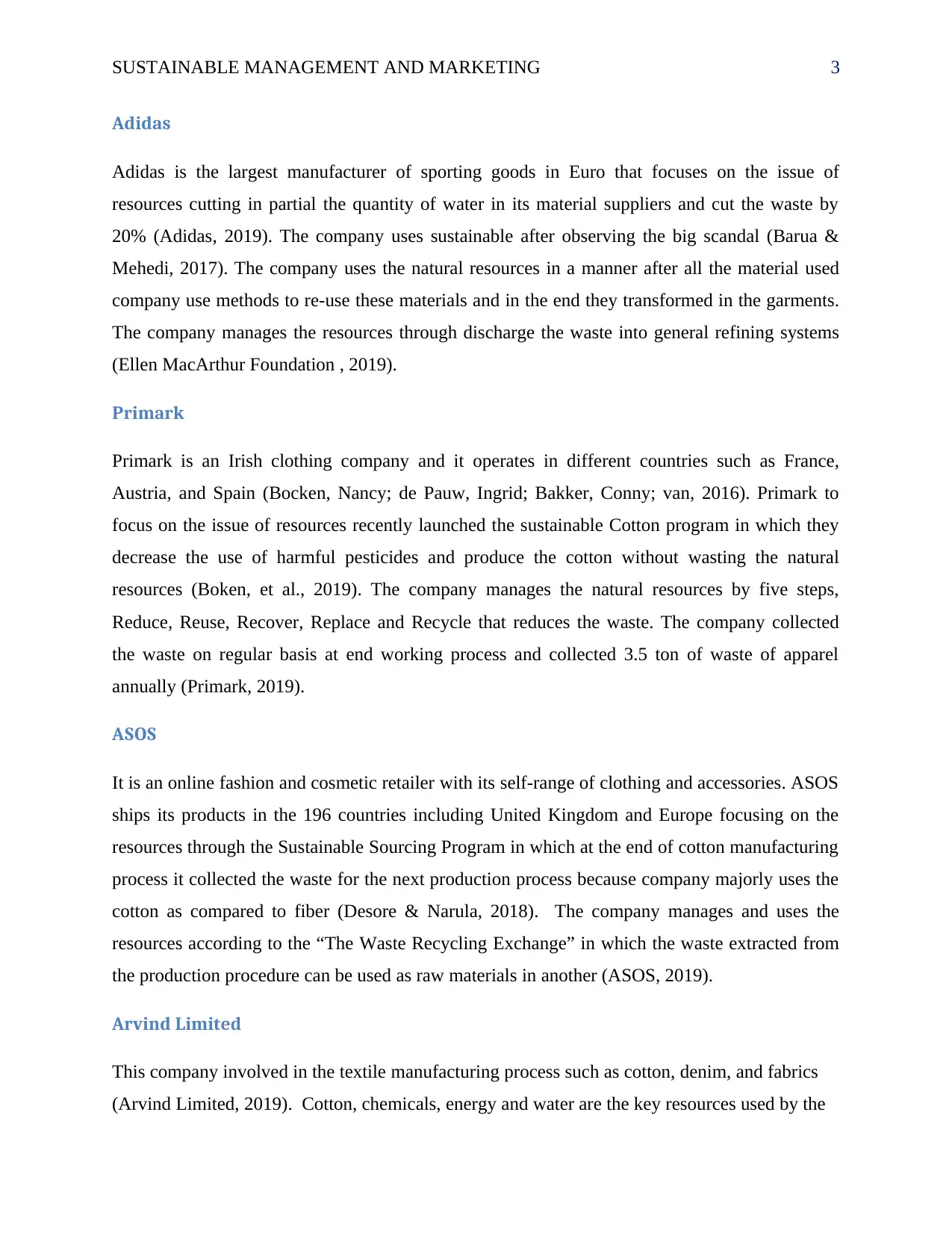
SUSTAINABLE MANAGEMENT AND MARKETING 3
Adidas
Adidas is the largest manufacturer of sporting goods in Euro that focuses on the issue of
resources cutting in partial the quantity of water in its material suppliers and cut the waste by
20% (Adidas, 2019). The company uses sustainable after observing the big scandal (Barua &
Mehedi, 2017). The company uses the natural resources in a manner after all the material used
company use methods to re-use these materials and in the end they transformed in the garments.
The company manages the resources through discharge the waste into general refining systems
(Ellen MacArthur Foundation , 2019).
Primark
Primark is an Irish clothing company and it operates in different countries such as France,
Austria, and Spain (Bocken, Nancy; de Pauw, Ingrid; Bakker, Conny; van, 2016). Primark to
focus on the issue of resources recently launched the sustainable Cotton program in which they
decrease the use of harmful pesticides and produce the cotton without wasting the natural
resources (Boken, et al., 2019). The company manages the natural resources by five steps,
Reduce, Reuse, Recover, Replace and Recycle that reduces the waste. The company collected
the waste on regular basis at end working process and collected 3.5 ton of waste of apparel
annually (Primark, 2019).
ASOS
It is an online fashion and cosmetic retailer with its self-range of clothing and accessories. ASOS
ships its products in the 196 countries including United Kingdom and Europe focusing on the
resources through the Sustainable Sourcing Program in which at the end of cotton manufacturing
process it collected the waste for the next production process because company majorly uses the
cotton as compared to fiber (Desore & Narula, 2018). The company manages and uses the
resources according to the “The Waste Recycling Exchange” in which the waste extracted from
the production procedure can be used as raw materials in another (ASOS, 2019).
Arvind Limited
This company involved in the textile manufacturing process such as cotton, denim, and fabrics
(Arvind Limited, 2019). Cotton, chemicals, energy and water are the key resources used by the
Adidas
Adidas is the largest manufacturer of sporting goods in Euro that focuses on the issue of
resources cutting in partial the quantity of water in its material suppliers and cut the waste by
20% (Adidas, 2019). The company uses sustainable after observing the big scandal (Barua &
Mehedi, 2017). The company uses the natural resources in a manner after all the material used
company use methods to re-use these materials and in the end they transformed in the garments.
The company manages the resources through discharge the waste into general refining systems
(Ellen MacArthur Foundation , 2019).
Primark
Primark is an Irish clothing company and it operates in different countries such as France,
Austria, and Spain (Bocken, Nancy; de Pauw, Ingrid; Bakker, Conny; van, 2016). Primark to
focus on the issue of resources recently launched the sustainable Cotton program in which they
decrease the use of harmful pesticides and produce the cotton without wasting the natural
resources (Boken, et al., 2019). The company manages the natural resources by five steps,
Reduce, Reuse, Recover, Replace and Recycle that reduces the waste. The company collected
the waste on regular basis at end working process and collected 3.5 ton of waste of apparel
annually (Primark, 2019).
ASOS
It is an online fashion and cosmetic retailer with its self-range of clothing and accessories. ASOS
ships its products in the 196 countries including United Kingdom and Europe focusing on the
resources through the Sustainable Sourcing Program in which at the end of cotton manufacturing
process it collected the waste for the next production process because company majorly uses the
cotton as compared to fiber (Desore & Narula, 2018). The company manages and uses the
resources according to the “The Waste Recycling Exchange” in which the waste extracted from
the production procedure can be used as raw materials in another (ASOS, 2019).
Arvind Limited
This company involved in the textile manufacturing process such as cotton, denim, and fabrics
(Arvind Limited, 2019). Cotton, chemicals, energy and water are the key resources used by the
Secure Best Marks with AI Grader
Need help grading? Try our AI Grader for instant feedback on your assignments.
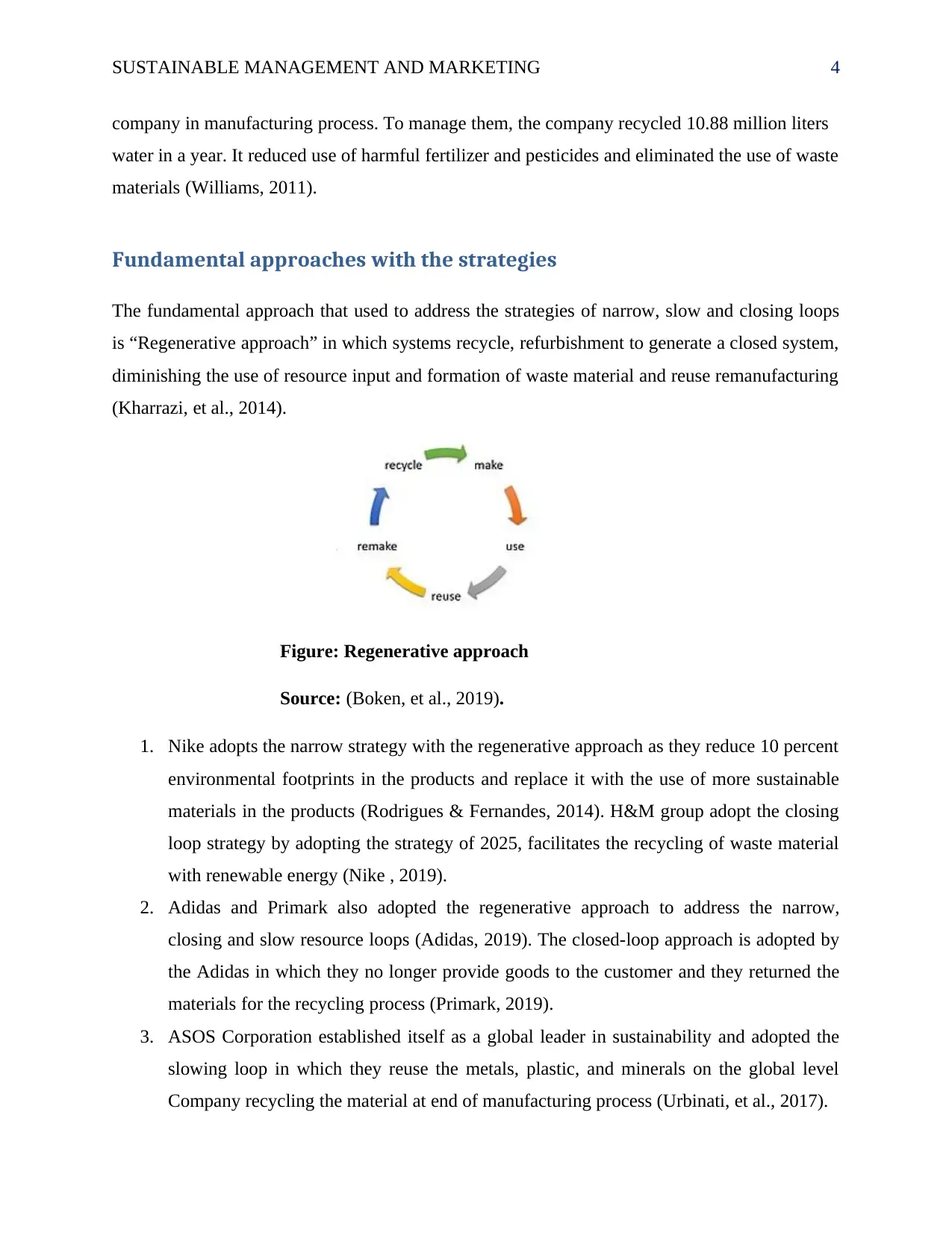
SUSTAINABLE MANAGEMENT AND MARKETING 4
company in manufacturing process. To manage them, the company recycled 10.88 million liters
water in a year. It reduced use of harmful fertilizer and pesticides and eliminated the use of waste
materials (Williams, 2011).
Fundamental approaches with the strategies
The fundamental approach that used to address the strategies of narrow, slow and closing loops
is “Regenerative approach” in which systems recycle, refurbishment to generate a closed system,
diminishing the use of resource input and formation of waste material and reuse remanufacturing
(Kharrazi, et al., 2014).
Figure: Regenerative approach
Source: (Boken, et al., 2019).
1. Nike adopts the narrow strategy with the regenerative approach as they reduce 10 percent
environmental footprints in the products and replace it with the use of more sustainable
materials in the products (Rodrigues & Fernandes, 2014). H&M group adopt the closing
loop strategy by adopting the strategy of 2025, facilitates the recycling of waste material
with renewable energy (Nike , 2019).
2. Adidas and Primark also adopted the regenerative approach to address the narrow,
closing and slow resource loops (Adidas, 2019). The closed-loop approach is adopted by
the Adidas in which they no longer provide goods to the customer and they returned the
materials for the recycling process (Primark, 2019).
3. ASOS Corporation established itself as a global leader in sustainability and adopted the
slowing loop in which they reuse the metals, plastic, and minerals on the global level
Company recycling the material at end of manufacturing process (Urbinati, et al., 2017).
company in manufacturing process. To manage them, the company recycled 10.88 million liters
water in a year. It reduced use of harmful fertilizer and pesticides and eliminated the use of waste
materials (Williams, 2011).
Fundamental approaches with the strategies
The fundamental approach that used to address the strategies of narrow, slow and closing loops
is “Regenerative approach” in which systems recycle, refurbishment to generate a closed system,
diminishing the use of resource input and formation of waste material and reuse remanufacturing
(Kharrazi, et al., 2014).
Figure: Regenerative approach
Source: (Boken, et al., 2019).
1. Nike adopts the narrow strategy with the regenerative approach as they reduce 10 percent
environmental footprints in the products and replace it with the use of more sustainable
materials in the products (Rodrigues & Fernandes, 2014). H&M group adopt the closing
loop strategy by adopting the strategy of 2025, facilitates the recycling of waste material
with renewable energy (Nike , 2019).
2. Adidas and Primark also adopted the regenerative approach to address the narrow,
closing and slow resource loops (Adidas, 2019). The closed-loop approach is adopted by
the Adidas in which they no longer provide goods to the customer and they returned the
materials for the recycling process (Primark, 2019).
3. ASOS Corporation established itself as a global leader in sustainability and adopted the
slowing loop in which they reuse the metals, plastic, and minerals on the global level
Company recycling the material at end of manufacturing process (Urbinati, et al., 2017).
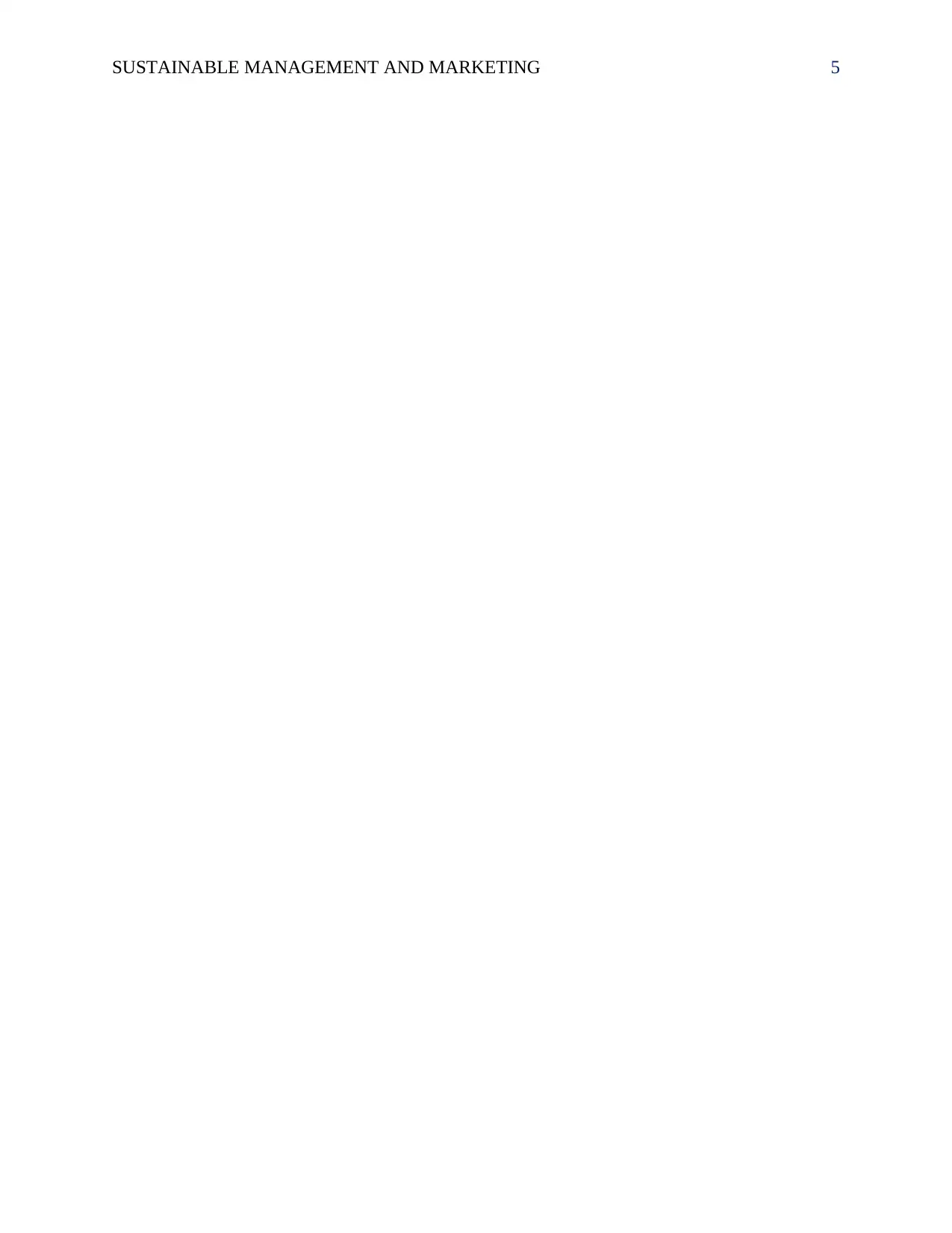
SUSTAINABLE MANAGEMENT AND MARKETING 5
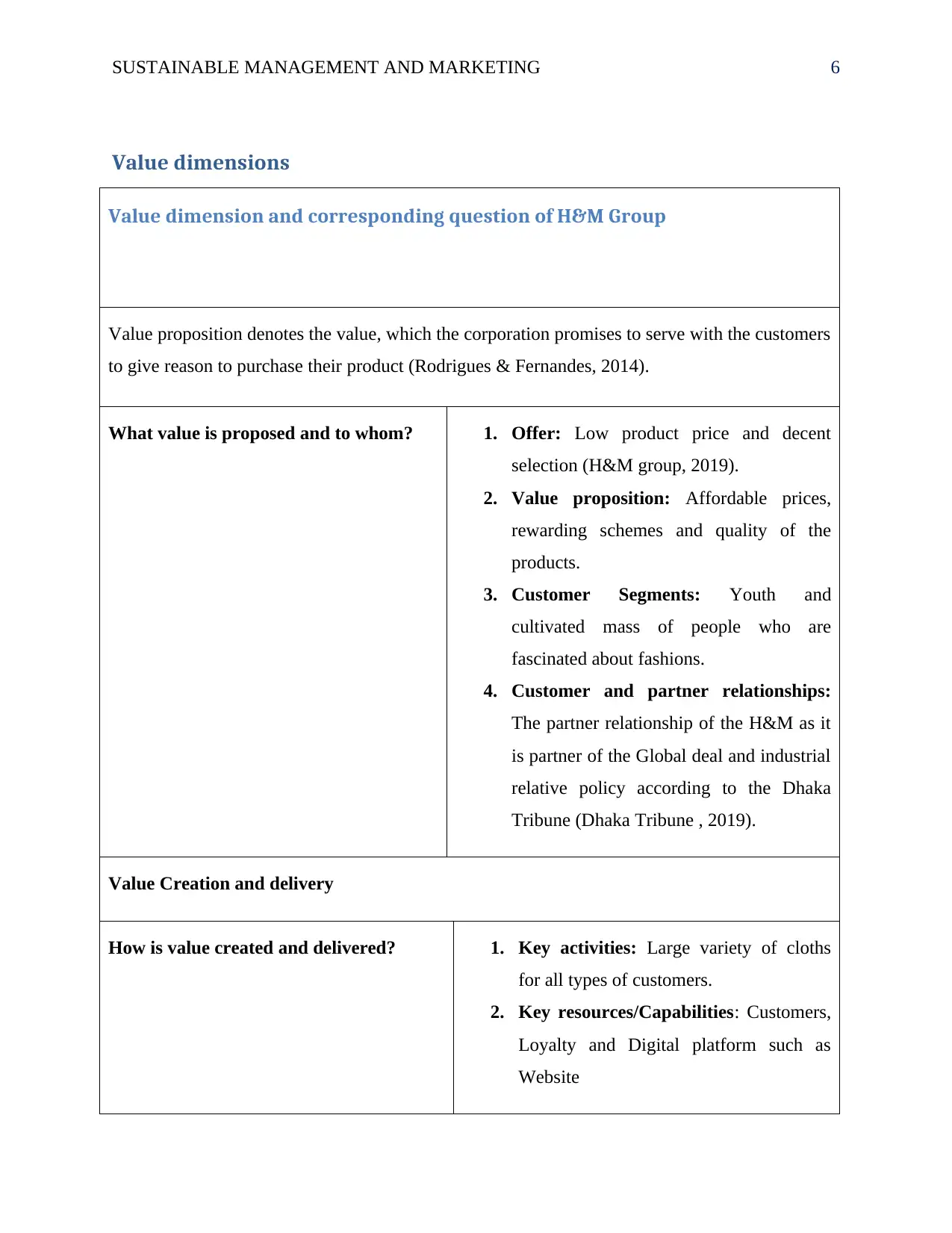
SUSTAINABLE MANAGEMENT AND MARKETING 6
Value dimensions
Value dimension and corresponding question of H&M Group
Value proposition denotes the value, which the corporation promises to serve with the customers
to give reason to purchase their product (Rodrigues & Fernandes, 2014).
What value is proposed and to whom? 1. Offer: Low product price and decent
selection (H&M group, 2019).
2. Value proposition: Affordable prices,
rewarding schemes and quality of the
products.
3. Customer Segments: Youth and
cultivated mass of people who are
fascinated about fashions.
4. Customer and partner relationships:
The partner relationship of the H&M as it
is partner of the Global deal and industrial
relative policy according to the Dhaka
Tribune (Dhaka Tribune , 2019).
Value Creation and delivery
How is value created and delivered? 1. Key activities: Large variety of cloths
for all types of customers.
2. Key resources/Capabilities: Customers,
Loyalty and Digital platform such as
Website
Value dimensions
Value dimension and corresponding question of H&M Group
Value proposition denotes the value, which the corporation promises to serve with the customers
to give reason to purchase their product (Rodrigues & Fernandes, 2014).
What value is proposed and to whom? 1. Offer: Low product price and decent
selection (H&M group, 2019).
2. Value proposition: Affordable prices,
rewarding schemes and quality of the
products.
3. Customer Segments: Youth and
cultivated mass of people who are
fascinated about fashions.
4. Customer and partner relationships:
The partner relationship of the H&M as it
is partner of the Global deal and industrial
relative policy according to the Dhaka
Tribune (Dhaka Tribune , 2019).
Value Creation and delivery
How is value created and delivered? 1. Key activities: Large variety of cloths
for all types of customers.
2. Key resources/Capabilities: Customers,
Loyalty and Digital platform such as
Website
Paraphrase This Document
Need a fresh take? Get an instant paraphrase of this document with our AI Paraphraser
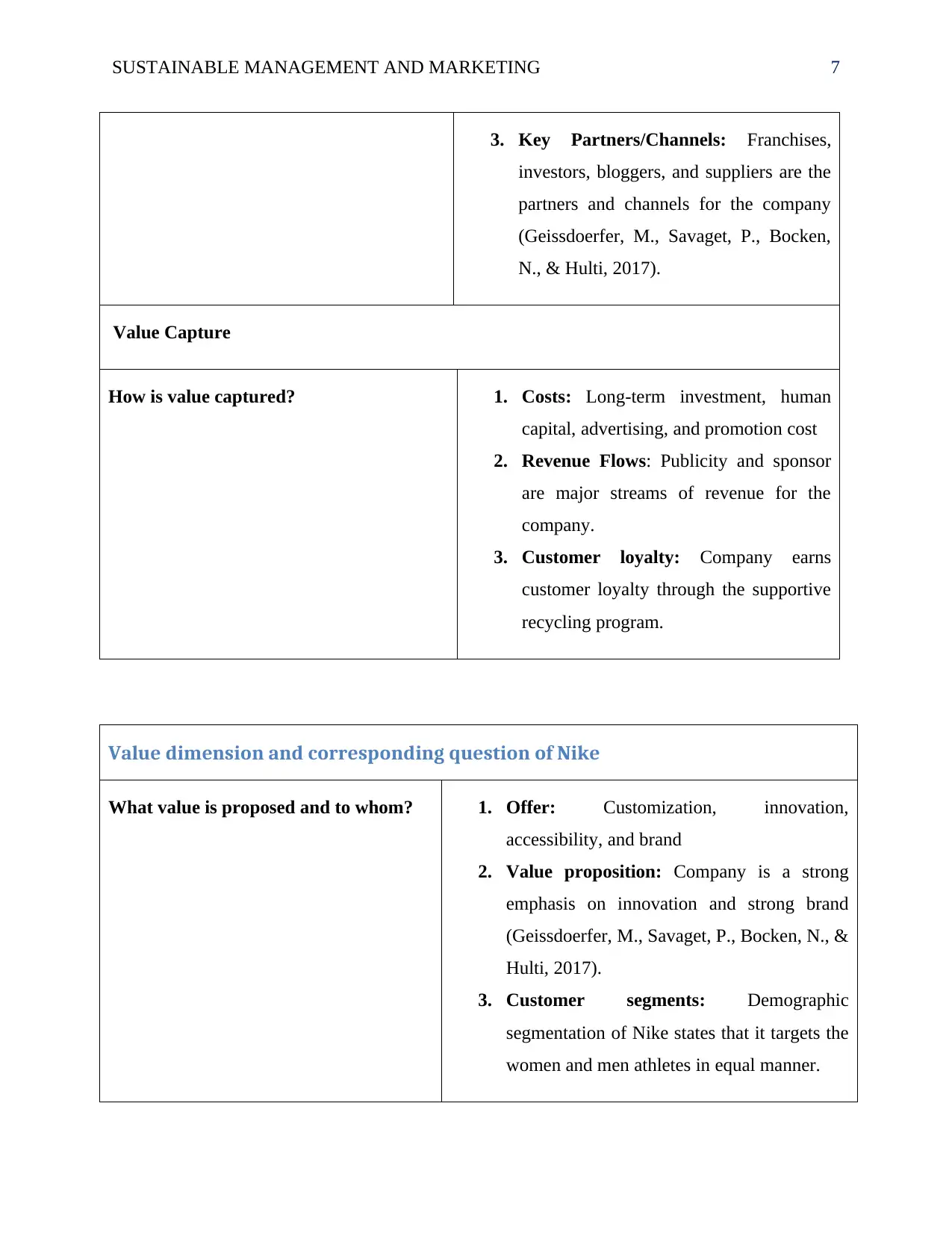
SUSTAINABLE MANAGEMENT AND MARKETING 7
3. Key Partners/Channels: Franchises,
investors, bloggers, and suppliers are the
partners and channels for the company
(Geissdoerfer, M., Savaget, P., Bocken,
N., & Hulti, 2017).
Value Capture
How is value captured? 1. Costs: Long-term investment, human
capital, advertising, and promotion cost
2. Revenue Flows: Publicity and sponsor
are major streams of revenue for the
company.
3. Customer loyalty: Company earns
customer loyalty through the supportive
recycling program.
Value dimension and corresponding question of Nike
What value is proposed and to whom? 1. Offer: Customization, innovation,
accessibility, and brand
2. Value proposition: Company is a strong
emphasis on innovation and strong brand
(Geissdoerfer, M., Savaget, P., Bocken, N., &
Hulti, 2017).
3. Customer segments: Demographic
segmentation of Nike states that it targets the
women and men athletes in equal manner.
3. Key Partners/Channels: Franchises,
investors, bloggers, and suppliers are the
partners and channels for the company
(Geissdoerfer, M., Savaget, P., Bocken,
N., & Hulti, 2017).
Value Capture
How is value captured? 1. Costs: Long-term investment, human
capital, advertising, and promotion cost
2. Revenue Flows: Publicity and sponsor
are major streams of revenue for the
company.
3. Customer loyalty: Company earns
customer loyalty through the supportive
recycling program.
Value dimension and corresponding question of Nike
What value is proposed and to whom? 1. Offer: Customization, innovation,
accessibility, and brand
2. Value proposition: Company is a strong
emphasis on innovation and strong brand
(Geissdoerfer, M., Savaget, P., Bocken, N., &
Hulti, 2017).
3. Customer segments: Demographic
segmentation of Nike states that it targets the
women and men athletes in equal manner.
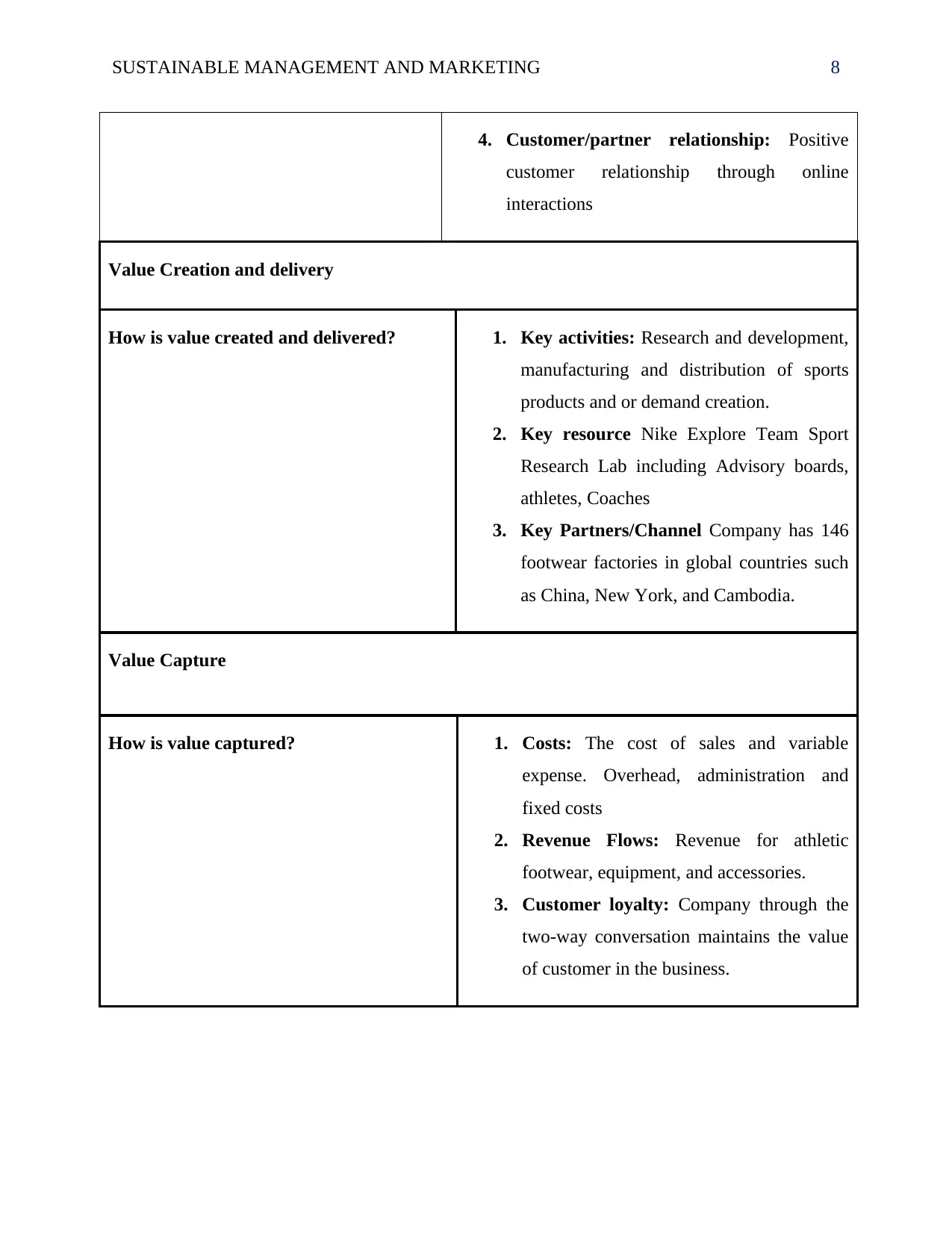
SUSTAINABLE MANAGEMENT AND MARKETING 8
4. Customer/partner relationship: Positive
customer relationship through online
interactions
Value Creation and delivery
How is value created and delivered? 1. Key activities: Research and development,
manufacturing and distribution of sports
products and or demand creation.
2. Key resource Nike Explore Team Sport
Research Lab including Advisory boards,
athletes, Coaches
3. Key Partners/Channel Company has 146
footwear factories in global countries such
as China, New York, and Cambodia.
Value Capture
How is value captured? 1. Costs: The cost of sales and variable
expense. Overhead, administration and
fixed costs
2. Revenue Flows: Revenue for athletic
footwear, equipment, and accessories.
3. Customer loyalty: Company through the
two-way conversation maintains the value
of customer in the business.
4. Customer/partner relationship: Positive
customer relationship through online
interactions
Value Creation and delivery
How is value created and delivered? 1. Key activities: Research and development,
manufacturing and distribution of sports
products and or demand creation.
2. Key resource Nike Explore Team Sport
Research Lab including Advisory boards,
athletes, Coaches
3. Key Partners/Channel Company has 146
footwear factories in global countries such
as China, New York, and Cambodia.
Value Capture
How is value captured? 1. Costs: The cost of sales and variable
expense. Overhead, administration and
fixed costs
2. Revenue Flows: Revenue for athletic
footwear, equipment, and accessories.
3. Customer loyalty: Company through the
two-way conversation maintains the value
of customer in the business.
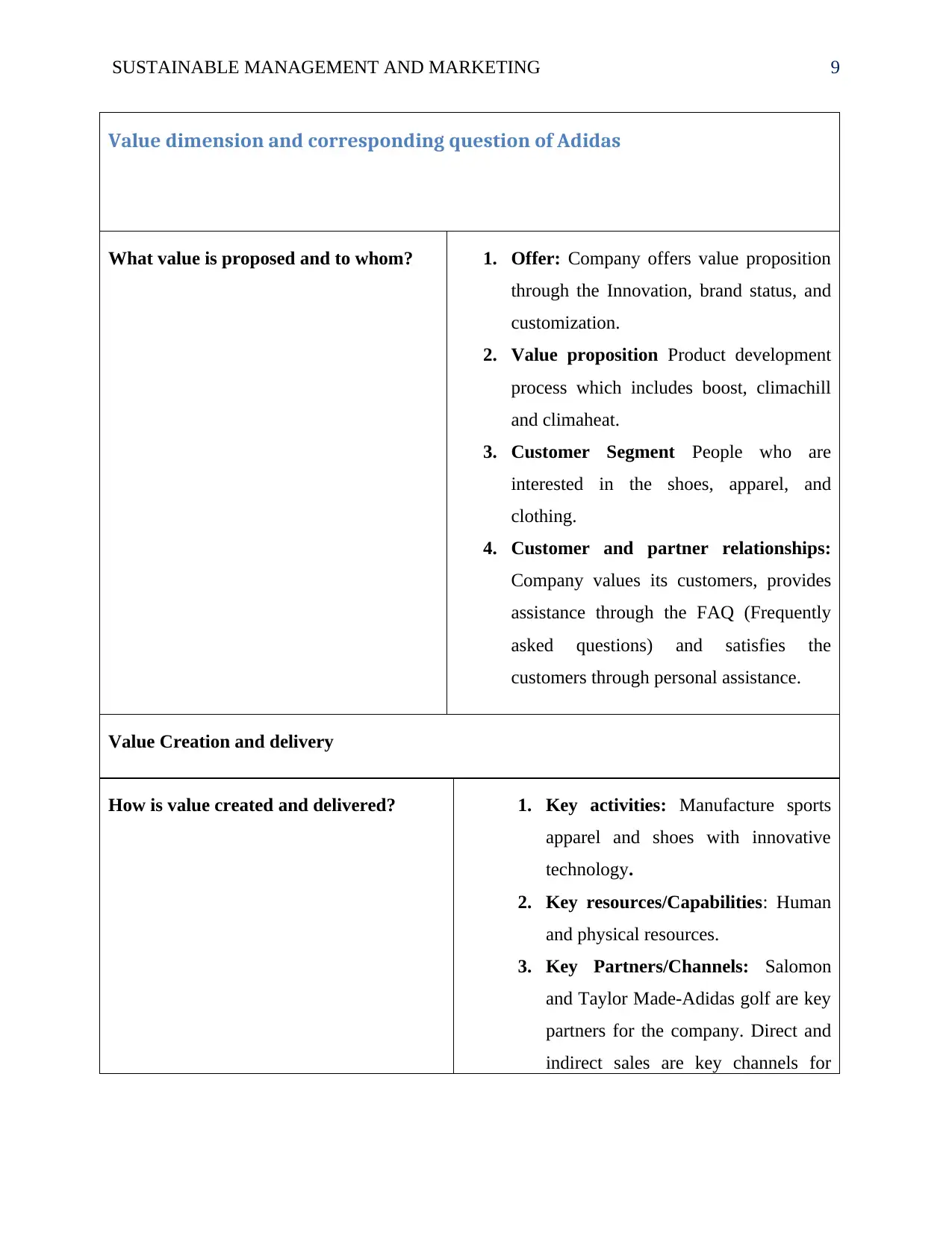
SUSTAINABLE MANAGEMENT AND MARKETING 9
Value dimension and corresponding question of Adidas
What value is proposed and to whom? 1. Offer: Company offers value proposition
through the Innovation, brand status, and
customization.
2. Value proposition Product development
process which includes boost, climachill
and climaheat.
3. Customer Segment People who are
interested in the shoes, apparel, and
clothing.
4. Customer and partner relationships:
Company values its customers, provides
assistance through the FAQ (Frequently
asked questions) and satisfies the
customers through personal assistance.
Value Creation and delivery
How is value created and delivered? 1. Key activities: Manufacture sports
apparel and shoes with innovative
technology.
2. Key resources/Capabilities: Human
and physical resources.
3. Key Partners/Channels: Salomon
and Taylor Made-Adidas golf are key
partners for the company. Direct and
indirect sales are key channels for
Value dimension and corresponding question of Adidas
What value is proposed and to whom? 1. Offer: Company offers value proposition
through the Innovation, brand status, and
customization.
2. Value proposition Product development
process which includes boost, climachill
and climaheat.
3. Customer Segment People who are
interested in the shoes, apparel, and
clothing.
4. Customer and partner relationships:
Company values its customers, provides
assistance through the FAQ (Frequently
asked questions) and satisfies the
customers through personal assistance.
Value Creation and delivery
How is value created and delivered? 1. Key activities: Manufacture sports
apparel and shoes with innovative
technology.
2. Key resources/Capabilities: Human
and physical resources.
3. Key Partners/Channels: Salomon
and Taylor Made-Adidas golf are key
partners for the company. Direct and
indirect sales are key channels for
Secure Best Marks with AI Grader
Need help grading? Try our AI Grader for instant feedback on your assignments.
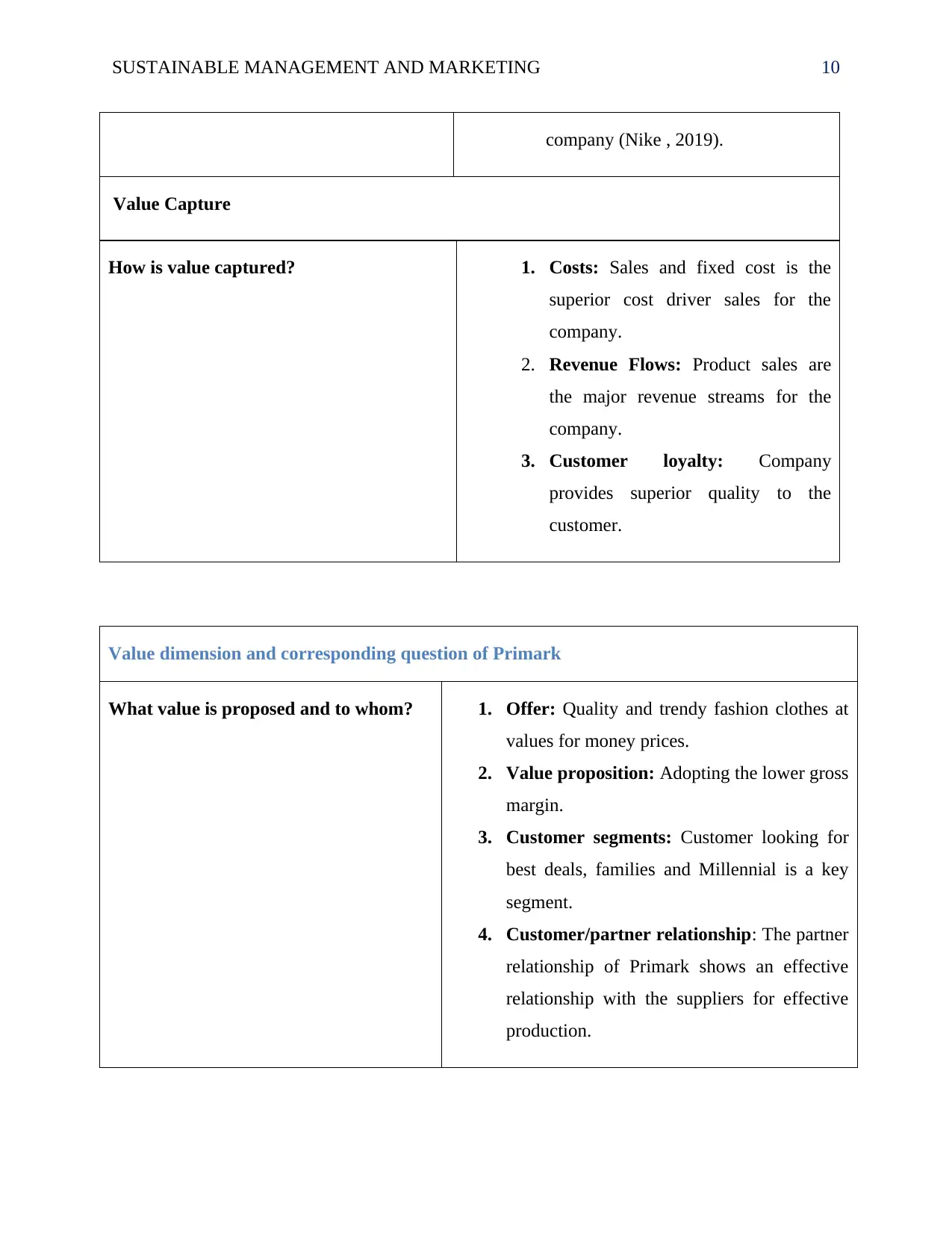
SUSTAINABLE MANAGEMENT AND MARKETING 10
company (Nike , 2019).
Value Capture
How is value captured? 1. Costs: Sales and fixed cost is the
superior cost driver sales for the
company.
2. Revenue Flows: Product sales are
the major revenue streams for the
company.
3. Customer loyalty: Company
provides superior quality to the
customer.
Value dimension and corresponding question of Primark
What value is proposed and to whom? 1. Offer: Quality and trendy fashion clothes at
values for money prices.
2. Value proposition: Adopting the lower gross
margin.
3. Customer segments: Customer looking for
best deals, families and Millennial is a key
segment.
4. Customer/partner relationship: The partner
relationship of Primark shows an effective
relationship with the suppliers for effective
production.
company (Nike , 2019).
Value Capture
How is value captured? 1. Costs: Sales and fixed cost is the
superior cost driver sales for the
company.
2. Revenue Flows: Product sales are
the major revenue streams for the
company.
3. Customer loyalty: Company
provides superior quality to the
customer.
Value dimension and corresponding question of Primark
What value is proposed and to whom? 1. Offer: Quality and trendy fashion clothes at
values for money prices.
2. Value proposition: Adopting the lower gross
margin.
3. Customer segments: Customer looking for
best deals, families and Millennial is a key
segment.
4. Customer/partner relationship: The partner
relationship of Primark shows an effective
relationship with the suppliers for effective
production.
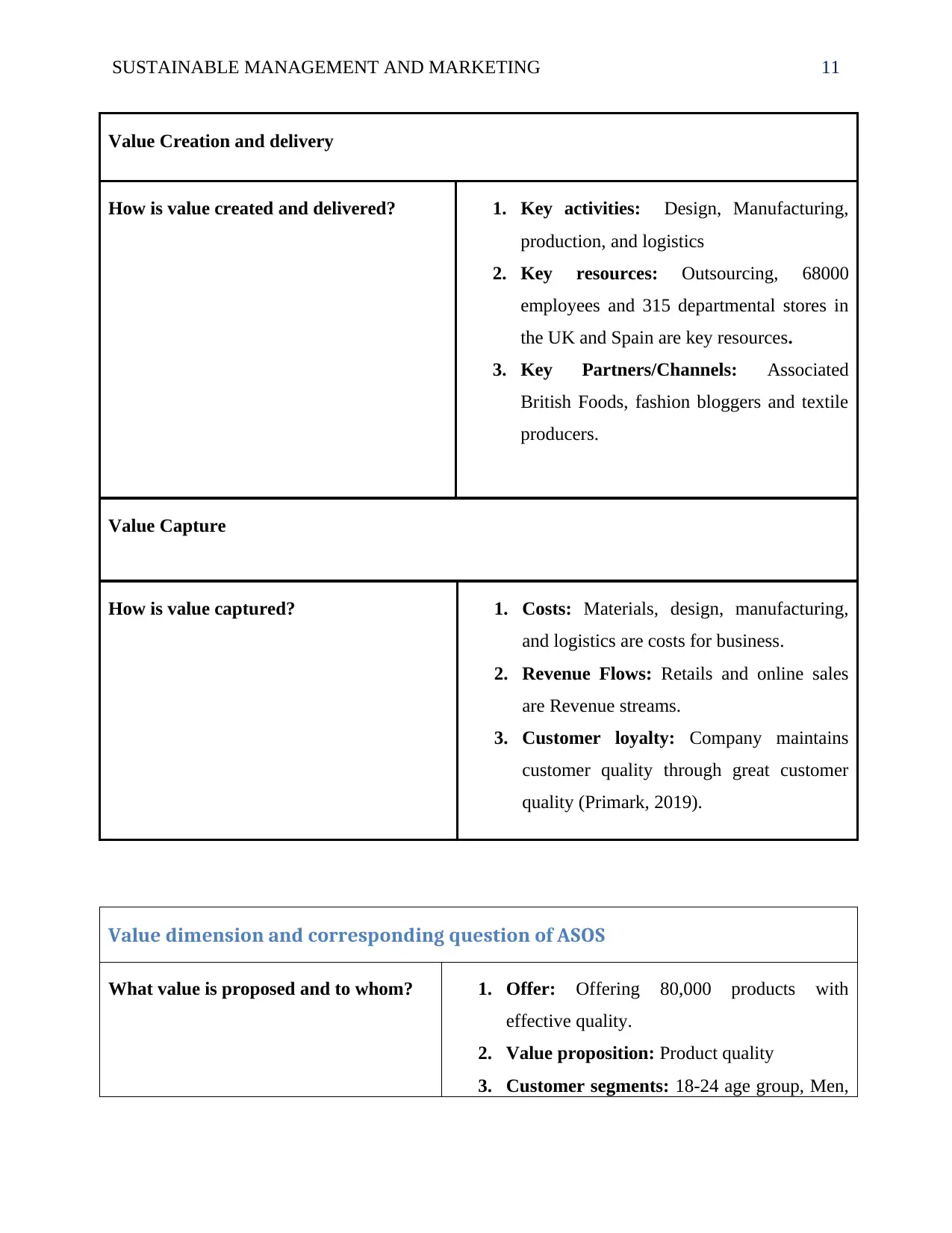
SUSTAINABLE MANAGEMENT AND MARKETING 11
Value Creation and delivery
How is value created and delivered? 1. Key activities: Design, Manufacturing,
production, and logistics
2. Key resources: Outsourcing, 68000
employees and 315 departmental stores in
the UK and Spain are key resources.
3. Key Partners/Channels: Associated
British Foods, fashion bloggers and textile
producers.
Value Capture
How is value captured? 1. Costs: Materials, design, manufacturing,
and logistics are costs for business.
2. Revenue Flows: Retails and online sales
are Revenue streams.
3. Customer loyalty: Company maintains
customer quality through great customer
quality (Primark, 2019).
Value dimension and corresponding question of ASOS
What value is proposed and to whom? 1. Offer: Offering 80,000 products with
effective quality.
2. Value proposition: Product quality
3. Customer segments: 18-24 age group, Men,
Value Creation and delivery
How is value created and delivered? 1. Key activities: Design, Manufacturing,
production, and logistics
2. Key resources: Outsourcing, 68000
employees and 315 departmental stores in
the UK and Spain are key resources.
3. Key Partners/Channels: Associated
British Foods, fashion bloggers and textile
producers.
Value Capture
How is value captured? 1. Costs: Materials, design, manufacturing,
and logistics are costs for business.
2. Revenue Flows: Retails and online sales
are Revenue streams.
3. Customer loyalty: Company maintains
customer quality through great customer
quality (Primark, 2019).
Value dimension and corresponding question of ASOS
What value is proposed and to whom? 1. Offer: Offering 80,000 products with
effective quality.
2. Value proposition: Product quality
3. Customer segments: 18-24 age group, Men,
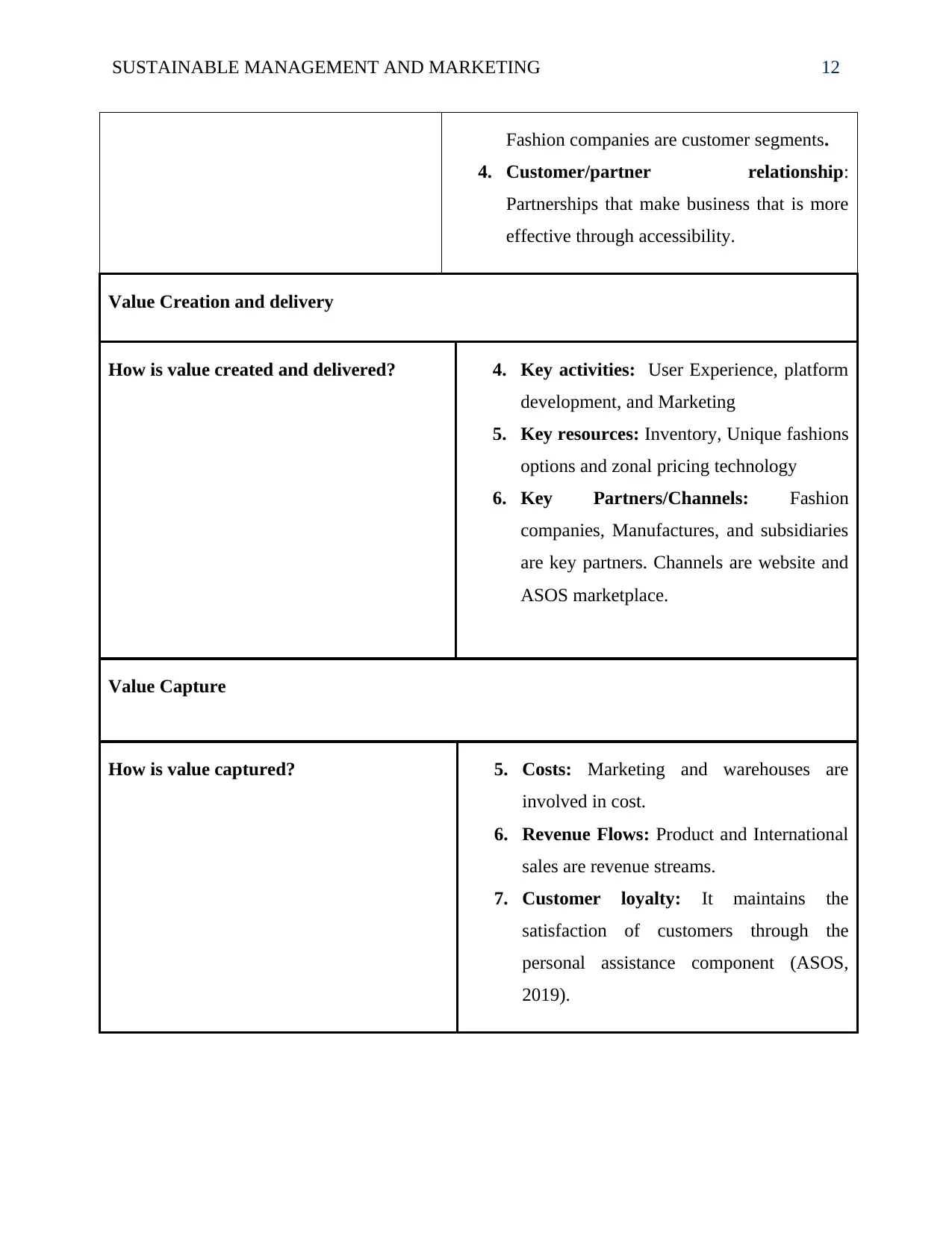
SUSTAINABLE MANAGEMENT AND MARKETING 12
Fashion companies are customer segments.
4. Customer/partner relationship:
Partnerships that make business that is more
effective through accessibility.
Value Creation and delivery
How is value created and delivered? 4. Key activities: User Experience, platform
development, and Marketing
5. Key resources: Inventory, Unique fashions
options and zonal pricing technology
6. Key Partners/Channels: Fashion
companies, Manufactures, and subsidiaries
are key partners. Channels are website and
ASOS marketplace.
Value Capture
How is value captured? 5. Costs: Marketing and warehouses are
involved in cost.
6. Revenue Flows: Product and International
sales are revenue streams.
7. Customer loyalty: It maintains the
satisfaction of customers through the
personal assistance component (ASOS,
2019).
Fashion companies are customer segments.
4. Customer/partner relationship:
Partnerships that make business that is more
effective through accessibility.
Value Creation and delivery
How is value created and delivered? 4. Key activities: User Experience, platform
development, and Marketing
5. Key resources: Inventory, Unique fashions
options and zonal pricing technology
6. Key Partners/Channels: Fashion
companies, Manufactures, and subsidiaries
are key partners. Channels are website and
ASOS marketplace.
Value Capture
How is value captured? 5. Costs: Marketing and warehouses are
involved in cost.
6. Revenue Flows: Product and International
sales are revenue streams.
7. Customer loyalty: It maintains the
satisfaction of customers through the
personal assistance component (ASOS,
2019).
Paraphrase This Document
Need a fresh take? Get an instant paraphrase of this document with our AI Paraphraser
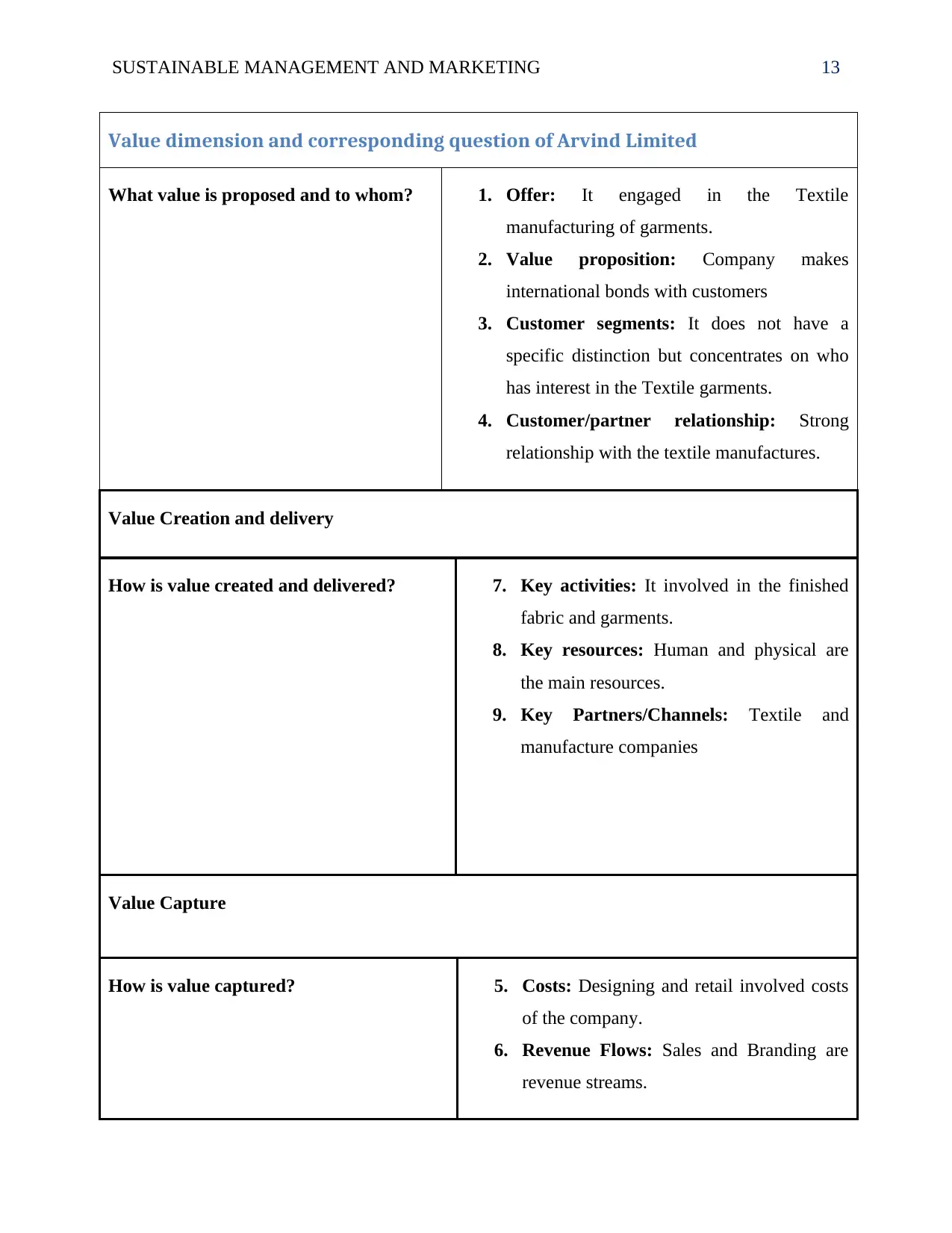
SUSTAINABLE MANAGEMENT AND MARKETING 13
Value dimension and corresponding question of Arvind Limited
What value is proposed and to whom? 1. Offer: It engaged in the Textile
manufacturing of garments.
2. Value proposition: Company makes
international bonds with customers
3. Customer segments: It does not have a
specific distinction but concentrates on who
has interest in the Textile garments.
4. Customer/partner relationship: Strong
relationship with the textile manufactures.
Value Creation and delivery
How is value created and delivered? 7. Key activities: It involved in the finished
fabric and garments.
8. Key resources: Human and physical are
the main resources.
9. Key Partners/Channels: Textile and
manufacture companies
Value Capture
How is value captured? 5. Costs: Designing and retail involved costs
of the company.
6. Revenue Flows: Sales and Branding are
revenue streams.
Value dimension and corresponding question of Arvind Limited
What value is proposed and to whom? 1. Offer: It engaged in the Textile
manufacturing of garments.
2. Value proposition: Company makes
international bonds with customers
3. Customer segments: It does not have a
specific distinction but concentrates on who
has interest in the Textile garments.
4. Customer/partner relationship: Strong
relationship with the textile manufactures.
Value Creation and delivery
How is value created and delivered? 7. Key activities: It involved in the finished
fabric and garments.
8. Key resources: Human and physical are
the main resources.
9. Key Partners/Channels: Textile and
manufacture companies
Value Capture
How is value captured? 5. Costs: Designing and retail involved costs
of the company.
6. Revenue Flows: Sales and Branding are
revenue streams.
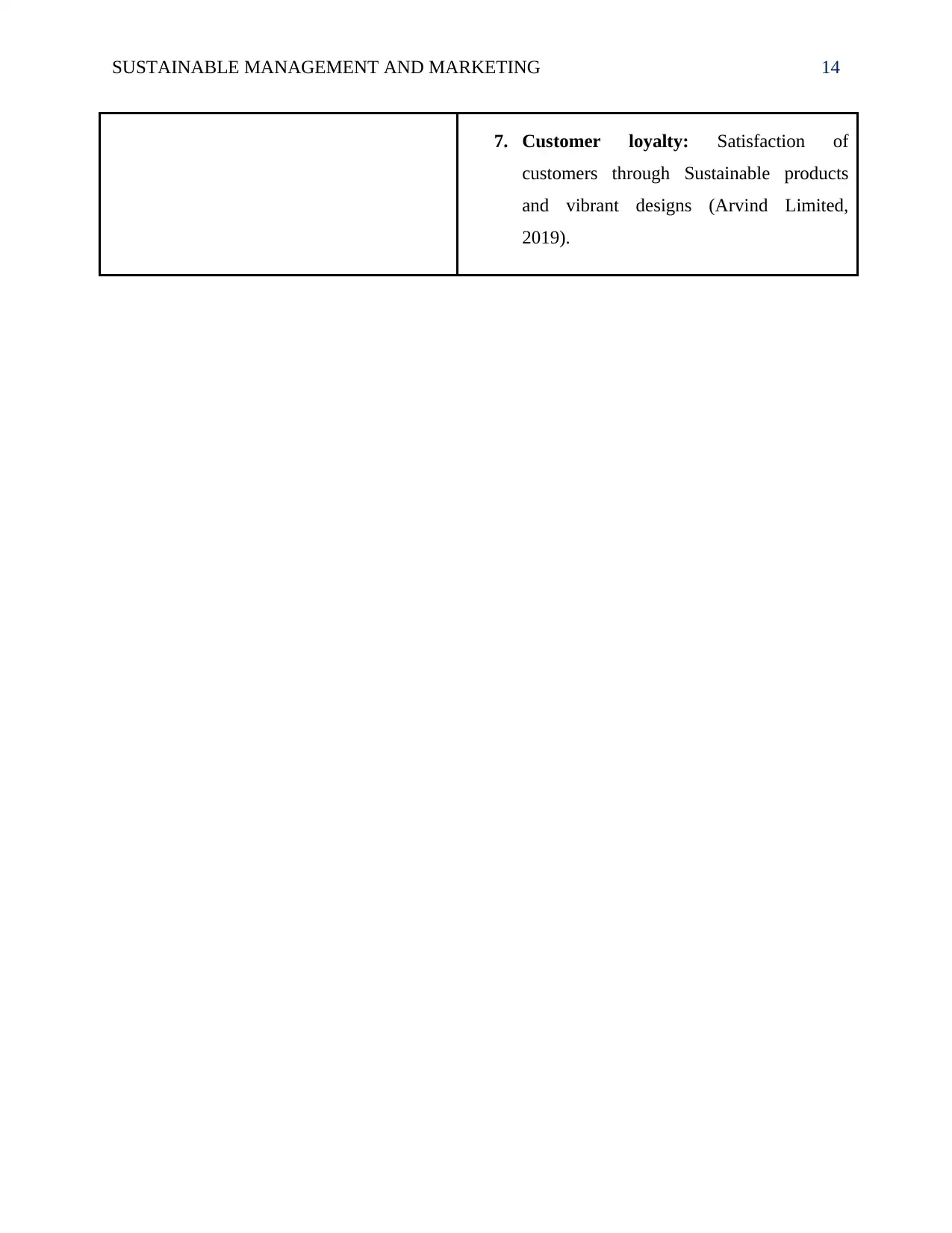
SUSTAINABLE MANAGEMENT AND MARKETING 14
7. Customer loyalty: Satisfaction of
customers through Sustainable products
and vibrant designs (Arvind Limited,
2019).
7. Customer loyalty: Satisfaction of
customers through Sustainable products
and vibrant designs (Arvind Limited,
2019).
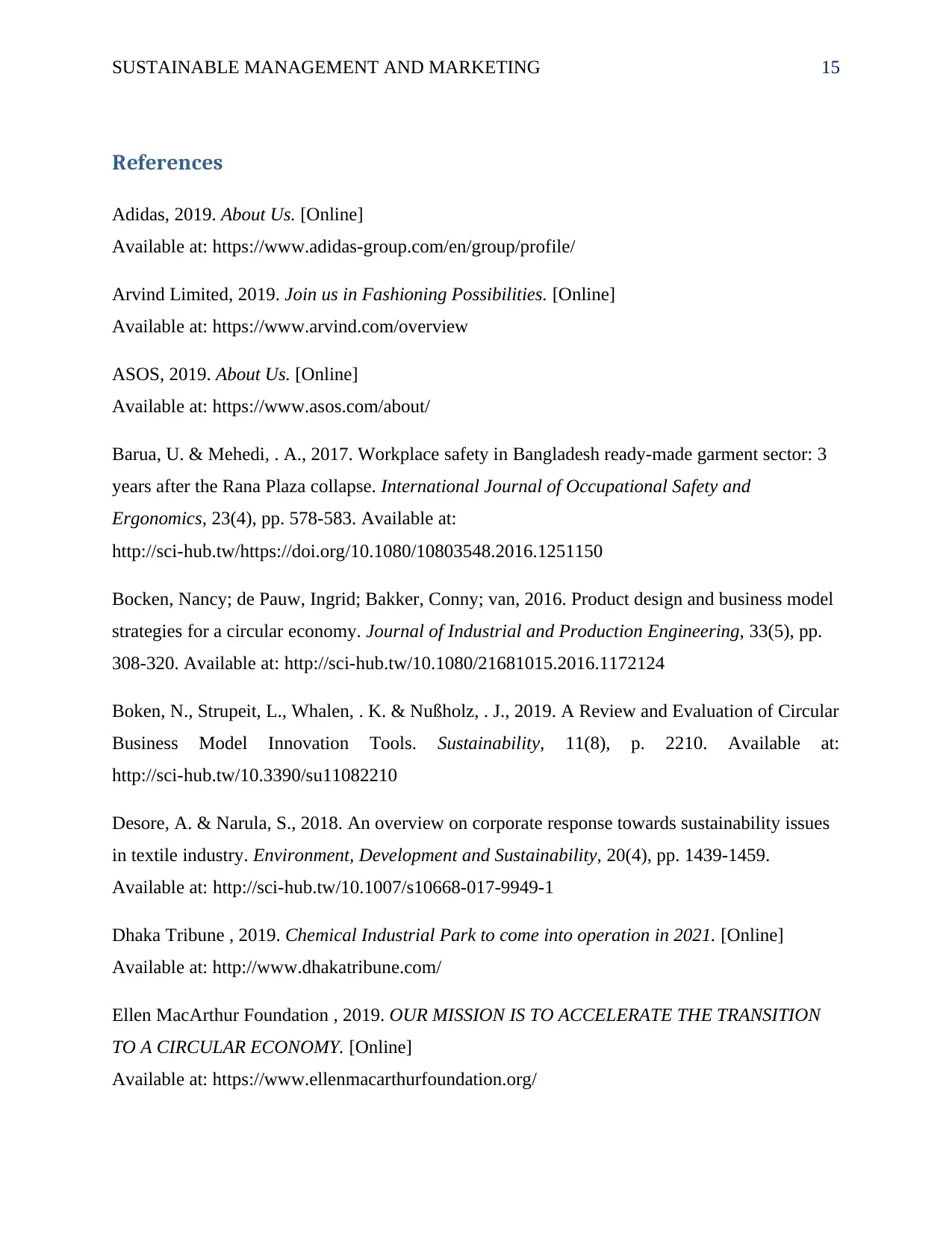
SUSTAINABLE MANAGEMENT AND MARKETING 15
References
Adidas, 2019. About Us. [Online]
Available at: https://www.adidas-group.com/en/group/profile/
Arvind Limited, 2019. Join us in Fashioning Possibilities. [Online]
Available at: https://www.arvind.com/overview
ASOS, 2019. About Us. [Online]
Available at: https://www.asos.com/about/
Barua, U. & Mehedi, . A., 2017. Workplace safety in Bangladesh ready-made garment sector: 3
years after the Rana Plaza collapse. International Journal of Occupational Safety and
Ergonomics, 23(4), pp. 578-583. Available at:
http://sci-hub.tw/https://doi.org/10.1080/10803548.2016.1251150
Bocken, Nancy; de Pauw, Ingrid; Bakker, Conny; van, 2016. Product design and business model
strategies for a circular economy. Journal of Industrial and Production Engineering, 33(5), pp.
308-320. Available at: http://sci-hub.tw/10.1080/21681015.2016.1172124
Boken, N., Strupeit, L., Whalen, . K. & Nußholz, . J., 2019. A Review and Evaluation of Circular
Business Model Innovation Tools. Sustainability, 11(8), p. 2210. Available at:
http://sci-hub.tw/10.3390/su11082210
Desore, A. & Narula, S., 2018. An overview on corporate response towards sustainability issues
in textile industry. Environment, Development and Sustainability, 20(4), pp. 1439-1459.
Available at: http://sci-hub.tw/10.1007/s10668-017-9949-1
Dhaka Tribune , 2019. Chemical Industrial Park to come into operation in 2021. [Online]
Available at: http://www.dhakatribune.com/
Ellen MacArthur Foundation , 2019. OUR MISSION IS TO ACCELERATE THE TRANSITION
TO A CIRCULAR ECONOMY. [Online]
Available at: https://www.ellenmacarthurfoundation.org/
References
Adidas, 2019. About Us. [Online]
Available at: https://www.adidas-group.com/en/group/profile/
Arvind Limited, 2019. Join us in Fashioning Possibilities. [Online]
Available at: https://www.arvind.com/overview
ASOS, 2019. About Us. [Online]
Available at: https://www.asos.com/about/
Barua, U. & Mehedi, . A., 2017. Workplace safety in Bangladesh ready-made garment sector: 3
years after the Rana Plaza collapse. International Journal of Occupational Safety and
Ergonomics, 23(4), pp. 578-583. Available at:
http://sci-hub.tw/https://doi.org/10.1080/10803548.2016.1251150
Bocken, Nancy; de Pauw, Ingrid; Bakker, Conny; van, 2016. Product design and business model
strategies for a circular economy. Journal of Industrial and Production Engineering, 33(5), pp.
308-320. Available at: http://sci-hub.tw/10.1080/21681015.2016.1172124
Boken, N., Strupeit, L., Whalen, . K. & Nußholz, . J., 2019. A Review and Evaluation of Circular
Business Model Innovation Tools. Sustainability, 11(8), p. 2210. Available at:
http://sci-hub.tw/10.3390/su11082210
Desore, A. & Narula, S., 2018. An overview on corporate response towards sustainability issues
in textile industry. Environment, Development and Sustainability, 20(4), pp. 1439-1459.
Available at: http://sci-hub.tw/10.1007/s10668-017-9949-1
Dhaka Tribune , 2019. Chemical Industrial Park to come into operation in 2021. [Online]
Available at: http://www.dhakatribune.com/
Ellen MacArthur Foundation , 2019. OUR MISSION IS TO ACCELERATE THE TRANSITION
TO A CIRCULAR ECONOMY. [Online]
Available at: https://www.ellenmacarthurfoundation.org/
Secure Best Marks with AI Grader
Need help grading? Try our AI Grader for instant feedback on your assignments.
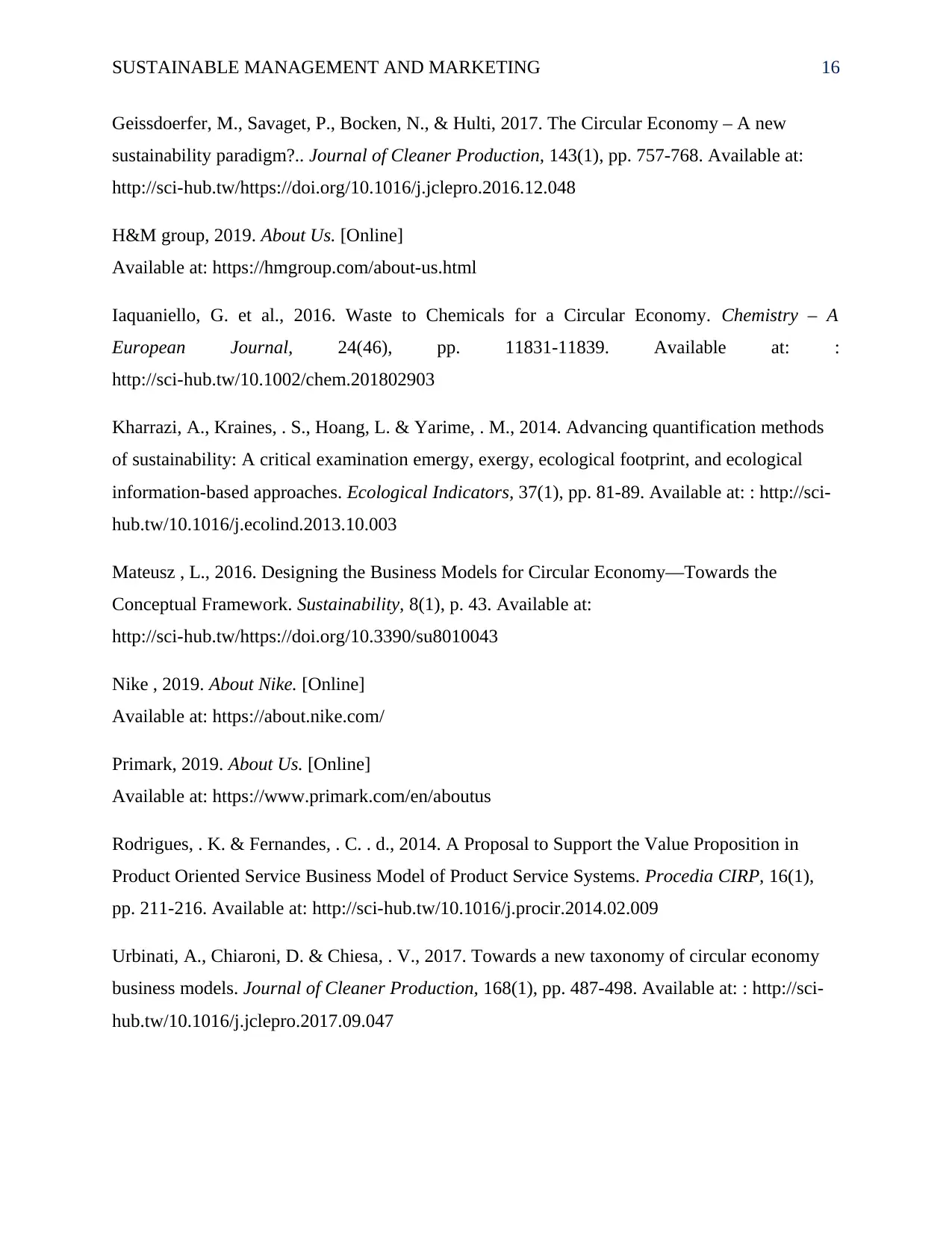
SUSTAINABLE MANAGEMENT AND MARKETING 16
Geissdoerfer, M., Savaget, P., Bocken, N., & Hulti, 2017. The Circular Economy – A new
sustainability paradigm?.. Journal of Cleaner Production, 143(1), pp. 757-768. Available at:
http://sci-hub.tw/https://doi.org/10.1016/j.jclepro.2016.12.048
H&M group, 2019. About Us. [Online]
Available at: https://hmgroup.com/about-us.html
Iaquaniello, G. et al., 2016. Waste to Chemicals for a Circular Economy. Chemistry – A
European Journal, 24(46), pp. 11831-11839. Available at: :
http://sci-hub.tw/10.1002/chem.201802903
Kharrazi, A., Kraines, . S., Hoang, L. & Yarime, . M., 2014. Advancing quantification methods
of sustainability: A critical examination emergy, exergy, ecological footprint, and ecological
information-based approaches. Ecological Indicators, 37(1), pp. 81-89. Available at: : http://sci-
hub.tw/10.1016/j.ecolind.2013.10.003
Mateusz , L., 2016. Designing the Business Models for Circular Economy—Towards the
Conceptual Framework. Sustainability, 8(1), p. 43. Available at:
http://sci-hub.tw/https://doi.org/10.3390/su8010043
Nike , 2019. About Nike. [Online]
Available at: https://about.nike.com/
Primark, 2019. About Us. [Online]
Available at: https://www.primark.com/en/aboutus
Rodrigues, . K. & Fernandes, . C. . d., 2014. A Proposal to Support the Value Proposition in
Product Oriented Service Business Model of Product Service Systems. Procedia CIRP, 16(1),
pp. 211-216. Available at: http://sci-hub.tw/10.1016/j.procir.2014.02.009
Urbinati, A., Chiaroni, D. & Chiesa, . V., 2017. Towards a new taxonomy of circular economy
business models. Journal of Cleaner Production, 168(1), pp. 487-498. Available at: : http://sci-
hub.tw/10.1016/j.jclepro.2017.09.047
Geissdoerfer, M., Savaget, P., Bocken, N., & Hulti, 2017. The Circular Economy – A new
sustainability paradigm?.. Journal of Cleaner Production, 143(1), pp. 757-768. Available at:
http://sci-hub.tw/https://doi.org/10.1016/j.jclepro.2016.12.048
H&M group, 2019. About Us. [Online]
Available at: https://hmgroup.com/about-us.html
Iaquaniello, G. et al., 2016. Waste to Chemicals for a Circular Economy. Chemistry – A
European Journal, 24(46), pp. 11831-11839. Available at: :
http://sci-hub.tw/10.1002/chem.201802903
Kharrazi, A., Kraines, . S., Hoang, L. & Yarime, . M., 2014. Advancing quantification methods
of sustainability: A critical examination emergy, exergy, ecological footprint, and ecological
information-based approaches. Ecological Indicators, 37(1), pp. 81-89. Available at: : http://sci-
hub.tw/10.1016/j.ecolind.2013.10.003
Mateusz , L., 2016. Designing the Business Models for Circular Economy—Towards the
Conceptual Framework. Sustainability, 8(1), p. 43. Available at:
http://sci-hub.tw/https://doi.org/10.3390/su8010043
Nike , 2019. About Nike. [Online]
Available at: https://about.nike.com/
Primark, 2019. About Us. [Online]
Available at: https://www.primark.com/en/aboutus
Rodrigues, . K. & Fernandes, . C. . d., 2014. A Proposal to Support the Value Proposition in
Product Oriented Service Business Model of Product Service Systems. Procedia CIRP, 16(1),
pp. 211-216. Available at: http://sci-hub.tw/10.1016/j.procir.2014.02.009
Urbinati, A., Chiaroni, D. & Chiesa, . V., 2017. Towards a new taxonomy of circular economy
business models. Journal of Cleaner Production, 168(1), pp. 487-498. Available at: : http://sci-
hub.tw/10.1016/j.jclepro.2017.09.047
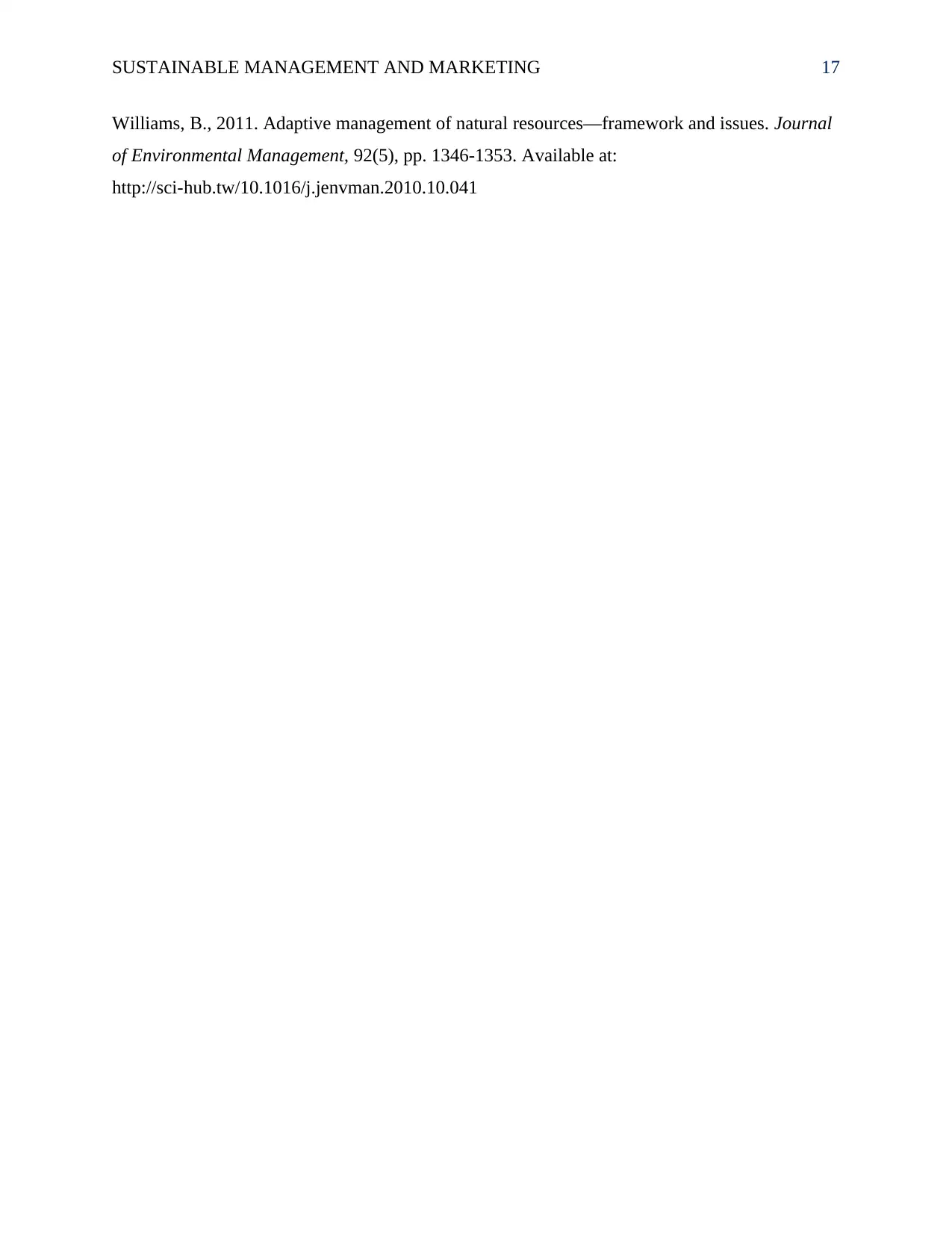
SUSTAINABLE MANAGEMENT AND MARKETING 17
Williams, B., 2011. Adaptive management of natural resources—framework and issues. Journal
of Environmental Management, 92(5), pp. 1346-1353. Available at:
http://sci-hub.tw/10.1016/j.jenvman.2010.10.041
Williams, B., 2011. Adaptive management of natural resources—framework and issues. Journal
of Environmental Management, 92(5), pp. 1346-1353. Available at:
http://sci-hub.tw/10.1016/j.jenvman.2010.10.041
1 out of 18
Related Documents
Your All-in-One AI-Powered Toolkit for Academic Success.
+13062052269
info@desklib.com
Available 24*7 on WhatsApp / Email
![[object Object]](/_next/static/media/star-bottom.7253800d.svg)
Unlock your academic potential
© 2024 | Zucol Services PVT LTD | All rights reserved.





